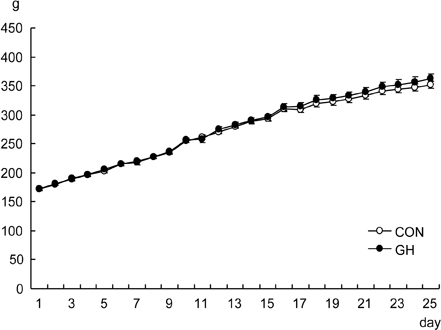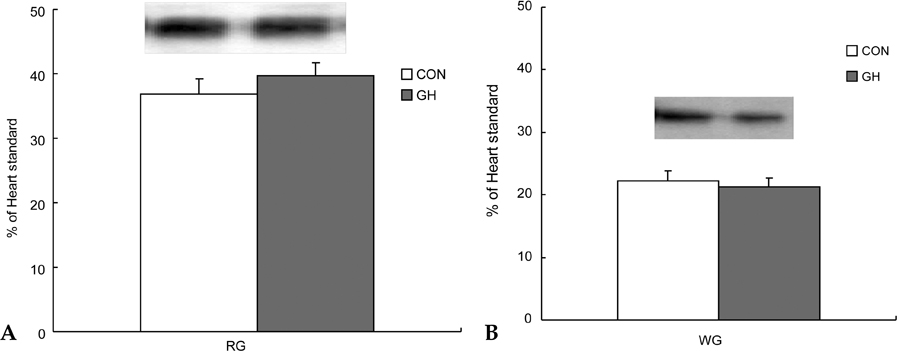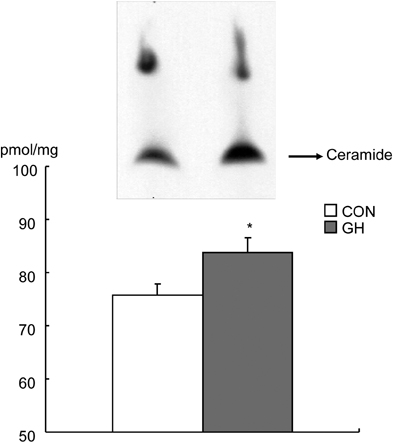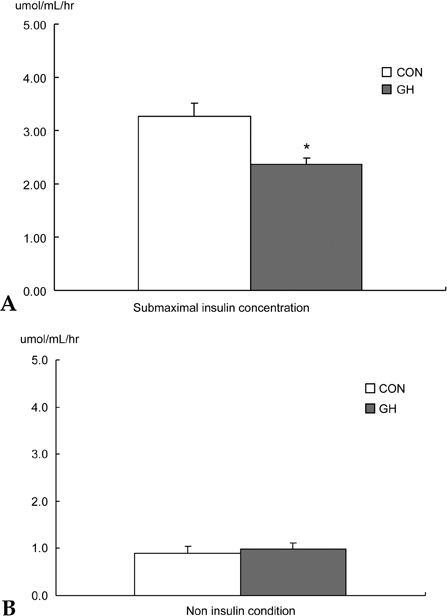Yonsei Med J.
2008 Dec;49(6):1008-1016. 10.3349/ymj.2008.49.6.1008.
Effects of 4 Weeks Recombinant Human Growth Hormone Administration on Insulin Resistance of Skeletal Muscle in Rats
- Affiliations
-
- 1Department of Pediatrics, Sanggye Paik Hospital, Inje University School of Medicine, Seoul, Korea. hokang62@hotmail.com
- 2Department of Physical Education, Kyungpook National University, Daegu, Korea.
- 3Human Performance Laboratory, Ball State University, Muncie, Indiana, USA.
- 4Department of Exercise and Wellness, Arizona State University, Mesa, Arizona, USA.
- KMID: 1782951
- DOI: http://doi.org/10.3349/ymj.2008.49.6.1008
Abstract
- PURPOSE
Effect of recombinant human growth hormone (rhGH) administration on lipid storage, and its subsequent effect on insulin sensitivity have not yet been adequately examined. Thus, we investigated the effects of rhGH treatment on muscle triglyceride (TG) and ceramide content, and insulin sensitivity after 4 weeks of rhGH administration in rats. MATERIALS AND METHODS: Fourteen rats were randomly assigned to two groups: rhGH injection group (GH, n = 7) and saline injection group (CON, n = 7). GH received rhGH by subcutaneous injections (130microgram/kg(-1)/day(-1), 6 days/week(-1)) for 4 weeks, while CON received saline injections that were equivalent in volume to GH group. Intramuscular TG and ceramide content and hepatic TG content were measured. To determine insulin sesitivity, oral glucose tolerance test (OGTT) and muscle incubation for glucose transport rate were performed in rats, and used as indicators of insulin sensitivity. We also examined plasm lipid profiles. RESULTS: After 4 weeks of rhGH treatment, the GH group had higher muscle and liver TG contents than the CON (p < 0.05). Ceramide content in GH was significantly greater than that in CON (p < 0.05). GH also had higher plasma levels of FFA (p < 0.05), glucose and insulin responses during OGTT (p < 0.05), and lower glucose transport rates in submaximal insulin concentration (p < 0.05) as compared with CON. Results indicate that rhGH treatment is associated with insulin resistance in rats. CONCLUSION: rhGH treatment elevated muscle TG and ceramide content, and hepatic TG content. Thus, elevation of these compounde by rhGH treatment could contribute to the development of insulin resistance in rats.
MeSH Terms
Figure
Reference
-
1. Doga M, Bonadonna S, Gola M, Mazziotti G, Giustina A. Growth hormone deficiency in the adult. Pituitary. 2006. 9:305–311.
Article2. Henwood MJ, Grimberg A, Moshang T Jr. Expanded spectrum of recombinant human growth hormone therapy. Curr Opin Pediatr. 2002. 14:437–442.
Article3. Woodhouse LJ, Mukherjee A, Shalet SM, Ezzat S. The influence of growth hormone status on physical impairments, functional limitations, and health-related quality of life in adults. Endocr Rev. 2006. 27:287–317.
Article4. Bramnert M, Segerlantz M, Laurila E, Daugaard JR, Manhem P, Groop L. Growth hormone replacement therapy induces insulin resistance by activating the glucose-fatty acid cycle. J Clin Endocrinol Metab. 2003. 88:1455–1463.
Article5. Cartee GD, Bohn EE. Growth hormone reduces glucose transport but not GLUT-1 or GLUT-4 in adult and old rats. Am J Physiol. 1995. 268(5 Pt 1):E902–E909.
Article6. Chrisoulidou A, Beshyah SA, Rutherford O, Spinks TJ, Mayet J, Kyd P, et al. Effects of 7 years of growth hormone replacement therapy in hypopituitary adults. J Clin Endocrinol Metab. 2000. 85:3762–3769.
Article7. Groop L, Segerlantz M, Bramnert M. Insulin sensitivity in adults with growth hormone deficiency and effect of growth hormone treatment. Horm Res. 2005. 64 Suppl 3:45–50.
Article8. Ng SF, Storlien LH, Kraegen EW, Stuart MC, Chapman GE, Lazarus L. Effect of biosynthetic human growth hormone on insulin action in individual tissues of the rat in vivo. Metabolism. 1990. 39:264–268.
Article9. Yuen KC, Dunger DB. Impact of treatment with recombinant human GH and IGF-I on visceral adipose tissue and glucose homeostasis in adults. Growth Horm IGF Res. 2006. 16 Suppl A:S55–S61.
Article10. Hou CW, Chou SW, Ho HY, Lee WC, Lin CH, Kuo CH. Interactive effect of exercise training and growth hormone administration on glucose tolerance and muscle GLUT4 protein expression in rats. J Biomed Sci. 2003. 10(6 Pt 2):689–696.
Article11. Riddick FA Jr, Reisler DM, Kipnis DM. The sugar transport system in striated muscle. Effect of growth hormone, hydrocortisone and alloxan diabetes. Diabetes. 1962. 11:171–178.12. Binnerts A, Swart GR, Wilson JH, Hoogerbrugge N, Pols HA, Birkenhager JC, et al. The effect of growth hormone administration in growth hormone deficient adults on bone, protein, carbohydrate and lipid homeostasis, as well as on body composition. Clin Endocrinol (Oxf). 1992. 37:79–87.
Article13. Ivy JL, Zderic TW, Fogt DL. Prevention and treatment of non-insulin-dependent diabetes mellitus. Exerc Sport Sci Rev. 1999. 27:1–35.14. Jørgensen JO, Krag M, Jessen N, Nørrelund H, Vestergaard ET, Moller N, et al. Growth hormone and glucose homeostasis. Horm Res. 2004. 62 Suppl 3:51–55.
Article15. Kim JK, Choi CS, Youn JH. Acute effect of growth hormone to induce peripheral insulin resistance is independent of FFA and insulin levels in rats. Am J Physiol. 1999. 277(4 Pt 1):E742–E749.
Article16. Møller N, Gjedsted J, Gormsen L, Fuglsang J, Djurhuus C. Effects of growth hormone on lipid metabolism in humans. Growth Horm IGF Res. 2003. 13 Suppl A:S18–S21.
Article17. Zisman A, Peroni OD, Abel ED, Michael MD, Mauvais-Jarvis F, Lowell BB, et al. Targeted disruption of the glucose transporter 4 selectively in muscle causes insulin resistance and glucose intolerance. Nat Med. 2000. 6:924–928.
Article18. Hegarty BD, Cooney GJ, Kraegen EW, Furler SM. Increased efficiency of fatty acid uptake contributes to lipid accumulation in skeletal muscle of high fat-fed insulin-resistant rats. Diabetes. 2002. 51:1477–1484.
Article19. Pan DA, Lillioja S, Kriketos AD, Milner MR, Baur LA, Bogardus C, et al. Skeletal muscle triglyceride levels are inversely related to insulin action. Diabetes. 1997. 46:983–988.
Article20. Kawano Y, Rincon J, Soler A, Ryder JW, Nolte LA, Zierath JR, et al. Changes in glucose transport and protein kinase Cbeta(2) in rat skeletal muscle induced by hyperglycaemia. Diabetologia. 1999. 42:1071–1079.
Article21. Young JC, Balon TW. Role of dihydropyridine sensitive calcium channels in glucose transport in skeletal muscle. Life Sci. 1997. 61:335–342.
Article22. Bielawska A, Perry DK, Hannun YA. Determination of ceramides and diglycerides by the diglyceride kinase assay. Anal Biochem. 2001. 298:141–150.
Article23. Burton AF, Anderson FH. Increased cholesteryl ester content in liver of mice fed lipid emulsion diets high in polyunsaturated fats. JPEN J Parenter Enteral Nutr. 1985. 9:480–482.
Article24. Morgan CR, Lazarow A. Immunoassay of insulin using a two-antibody system. Proc Soc Exp Biol Med. 1962. 110:29–32.
Article25. Noma A, Okabe H, Kita M. [Determination of serum cholinesterase activity by means of automatic titration]. Rinsho Byori. 1973. 21:457–460.26. Virkamäki A, Korsheninnikova E, Seppälä-Lindroos A, Vehkavaara S, Goto T, Halavaara J, et al. Intramyocellular lipid is associated with resistance to in vivo insulin actions on glucose uptake, antilipolysis, and early insulin signaling pathways in human skeletal muscle. Diabetes. 2001. 50:2337–2343.27. Summers SA. Ceramides in insulin resistance and lipotoxicity. Prog Lipid Res. 2006. 45:42–72.
Article28. Summers SA, Garza LA, Zhou H, Birnbaum MJ. Regulation of insulin-stimulated glucose transporter GLUT4 translocation and Akt kinase activity by ceramide. Mol Cell Biol. 1998. 18:5457–5464.
Article29. Straczkowski M, Kowalska I, Baranowski M, Nikolajuk A, Otziomek E, Zabielski P, et al. Increased skeletal muscle ceramide level in men at risk of developing type 2 diabetes. Diabetologia. 2007. 50:2366–2373.
Article30. Schmitz-Peiffer C, Craig DL, Biden TJ. Ceramide generation is sufficient to account for the inhibition of the insulin-stimulated PKB pathway in C2C12 skeletal muscle cells pretreated with palmitate. J Biol Chem. 1999. 274:24202–24210.
Article31. Krag MB, Gormsen LC, Guo Z, Christiansen JS, Jensen MD, Nielsen S, et al. Growth hormone-induced insulin resistance is associated with increased intramyocellular triglyceride content but unaltered VLDL-triglyceride kinetics. Am J Physiol Endocrinol Metab. 2007. 292:E920–E927.
Article32. Segerlantz M, Bramnert M, Manhem P, Laurila E, Groop LC. Inhibition of lipolysis during acute GH exposure increases insulin sensitivity in previously untreated GH-deficient adults. Eur J Endocrinol. 2003. 149:511–519.
Article33. Adiels M, Taskinen MR, Packard C, Caslake MJ, Soro-Paavonen A, Westerbacka J, et al. Overproduction of large VLDL particles is driven by increased liver fat content in man. Diabetologia. 2006. 49:755–765.
Article34. Boden G, Shulman GI. Free fatty acids in obesity and type 2 diabetes: defining their role in the development of insulin resistance and beta-cell dysfunction. Eur J Clin Invest. 2002. 32 Suppl 3:14–23.35. McGarry JD. Banting lecture 2001: dysregulation of fatty acid metabolism in the etiology of type 2 diabetes. Diabetes. 2002. 51:7–18.36. Johansen T, Richelsen B, Hansen HS, Din N, Malmlöf K. Growth hormone-mediated breakdown of body fat: effects of GH on lipases in adipose tissue and skeletal muscle of old rats fed different diets. Horm Metab Res. 2003. 35:243–250.
Article37. Yip RG, Goodman HM. Growth hormone and dexamethasone stimulate lipolysis and activate adenylyl cyclase in rat adipocytes by selectively shifting Gi alpha2 to lower density membrane fractions. Endocrinology. 1999. 140:1219–1227.
Article38. Louveau I, Gondret F. Regulation of development and metabolism of adipose tissue by growth hormone and the insulin-like growth factor system. Domest Anim Endocrinol. 2004. 27:241–255.
Article39. Richelsen B. Effect of growth hormone on adipose tissue and skeletal muscle lipoprotein lipase activity in humans. J Endocrinol Invest. 1999. 22:5 Suppl. 10–15.40. Randle PJ, Garland PB, Hales CN, Newsholme EA. The glucose fatty-acid cycle. Its role in insulin sensitivity and the metabolic disturbances of diabetes mellitus. Lancet. 1963. 1:785–789.
Article41. Cartee GD. What insights into age-related changes in skeletal muscle are provided by animal models? J Gerontol A Biol Sci Med Sci. 1995. 50 Spec No:137–141.42. Christopher M, Hew FL, Oakley M, Rantzau C, Alford F. Defects of insulin action and skeletal muscle glucose metabolism in growth hormone-deficient adults persist after 24 months of recombinant human growth hormone therapy. J Clin Endocrinol Metab. 1998. 83:1668–1681.
Article43. Jessen N, Djurhuus CB, Jørgensen JO, Jensen LS, Møller N, Lund S, et al. Evidence against a role for insulin-signaling proteins PI 3-kinase and Akt in insulin resistance in human skeletal muscle induced by short-term GH infusion. Am J Physiol Endocrinol Metab. 2005. 288:E194–E199.
Article44. Boden G. Effects of free fatty acids (FFA) on glucose metabolism: significance for insulin resistance and type 2 diabetes. Exp Clin Endocrinol Diabetes. 2003. 111:121–124.
Article45. Goodpaster BH, Thaete FL, Kelley DE. Thigh adipose tissue distribution is associated with insulin resistance in obesity and in type 2 diabetes mellitus. Am J Clin Nutr. 2000. 71:885–892.
Article46. Stannard SR, Johnson NA. Insulin resistance and elevated triglyceride in muscle: more important for survival than "thrifty" genes? J Physiol. 2004. 554(Pt 3):595–607.
Article47. Hegarty BD, Furler SM, Ye J, Cooney GJ, Kraegen EW. The role of intramuscular lipid in insulin resistance. Acta Physiol Scand. 2003. 178:373–383.
Article48. Henriksen EJ, Bourey RE, Rodnick KJ, Koranyi L, Permutt MA, Holloszy JO. Glucose transporter protein content and glucose transport capacity in rat skeletal muscles. Am J Physiol. 1990. 259(4 Pt 1):E593–E598.
Article
- Full Text Links
- Actions
-
Cited
- CITED
-
- Close
- Share
- Similar articles
-
- Effects of growth hormone on glucose metabolism and insulin resistance in human
- The Effects of Growth Hormone Tretment on Body Composition and Glucose Metabolism in Adult Hypophysectomized Rats
- Effect of Age on Glucose Metabolism of Skeletal Muscle in Rats
- Effect of yeast-derived methionyl recombinant growth hormone on growth hormone deficient dwarf
- Insulin Resistance and Intracellular Thyroid Hormone Dysfunction








